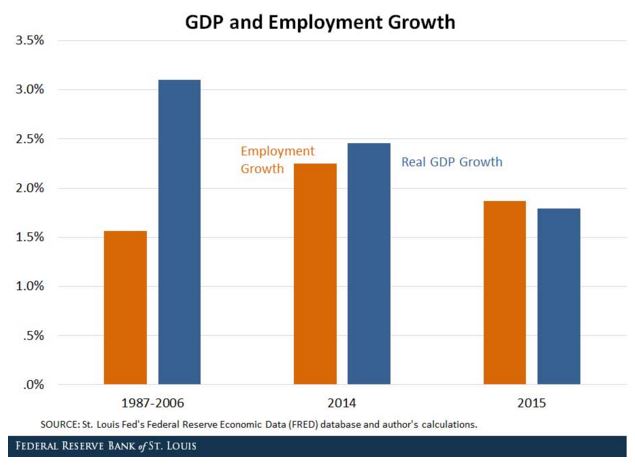 The nation’s real GDP has grown at a slower rate in the last two years while employment numbers have grown at a faster rate relative to their historical records. While it may be too early to declare a trend, what will it mean if these two central measures of the economy continue on the paths they’ve taken the last two years?
The nation’s real GDP has grown at a slower rate in the last two years while employment numbers have grown at a faster rate relative to their historical records. While it may be too early to declare a trend, what will it mean if these two central measures of the economy continue on the paths they’ve taken the last two years?
According to William Dupor, Assistant VP and Economist for the St. Louis Fed, it will mean that the nation has entered a decline in the number of technology-related jobs available.
The GDP grew at an average yearly rate of 3.1 percent from 1987 to 2006, which is the 20-year period prior to the recession, while employment grew at a rate of 1.6 percent during that same period. In 2015, GDP growth is likely to finish the year at a rate of around 1.8 percent (the first estimate for Q4 released last week was 0.7 percent). Employment grew at a rate of 1.9 percent for 2015 compared to the projected 1.8 percent for GDP, with a similar pattern happening in 2014, according to Dupor.
Among other things, the GDP includes consumer goods and services as well as the buildings and equipment companies use; therefore, Dupor said, “The overriding reason that real GDP grows faster than employment over longer horizons is technology. As technology improves over time, workers become more productive, generating more GDP per worker.”
If the GDP and employment rates continue to grow at their respective anomalous rates from the last two years and do not return to the pre-recession growth pattern, Dupor says, “The most disheartening explanation might be that the economy has downshifted into a period of slow technological growth that could last for many years.”
 While the recent employment reports have been positive as far as the number of jobs created, wage growth has been stagnant—and wage growth has been cited by many economists as the key to increasing household formation and raising a homeownership rate which fell to a 48-year low in the second quarter of 2015.
While the recent employment reports have been positive as far as the number of jobs created, wage growth has been stagnant—and wage growth has been cited by many economists as the key to increasing household formation and raising a homeownership rate which fell to a 48-year low in the second quarter of 2015.
The Bureau of Labor Statistics reported in its December 2015 Employment Summary that wage growth still fails to dazzle, with average hourly earnings for all employees on private nonfarm payrolls in December down by 1 cent at $25.24. This came after a 5 cent increase in November. For the entire year of 2015, average hourly earnings rose by 2.5 percent.
Paul Ashworth, Chief US Economist at Capital Economics. says that wage growth was the only disappointment in the BLS report, and “a meaningful pick-up in wage growth is still the missing piece of the puzzle in this recovery, but the survey evidence suggests it will arrive soon.”

 DSNews The homepage of the servicing industry
DSNews The homepage of the servicing industry










